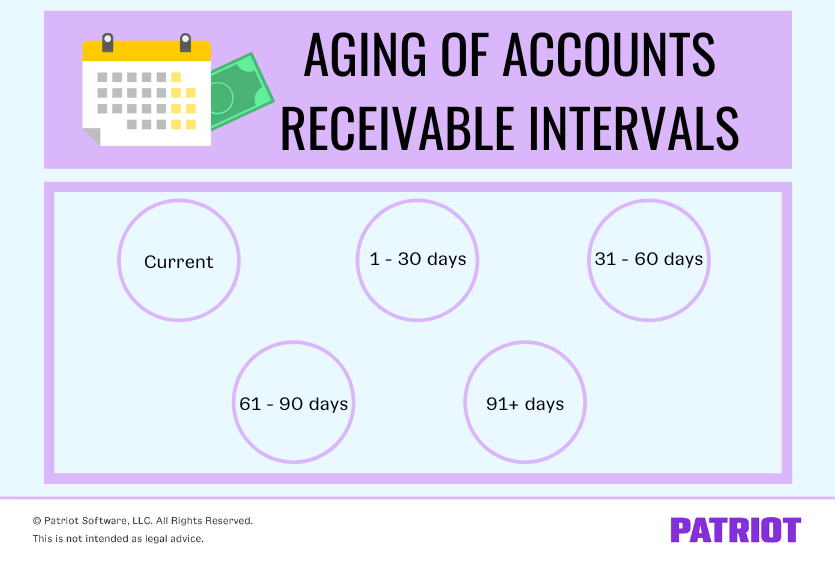If you offer credit to customers at your small business, you have accounts receivable (AR). Sometimes customers pay on time, while other times they do not. Aging of accounts receivable comes into play when a customer has a past due invoice. Keep reading to learn all about aging of AR and how it can help your business.
Aging of accounts receivable
Before you go down the rabbit hole of aging of accounts receivable, you have to know what accounts receivable is. Accounts receivable is any money owed to your business from a sale on credit. The entries in your AR are called receivables. The receivables in your books represent outstanding invoices. You have accounts receivables if you extend credit to customers (e.g., you invoice a customer and they pay you at a later date).
The “aging” of accounts receivable refers to the number of days an invoice is past due. Businesses can use aging of accounts receivable to track and collect overdue bills.
Prepare an aging of accounts receivable report to see the age of outstanding invoices. Generally, the report is broken up into a few intervals:
- Current (due immediately)
- 1 – 30 days
- 31 – 60 days
- 61 – 90 days
- 91+ days
Intervals, also referred to as an aging schedule, vary depending on your preference or the accounting platform you use. Either way, the past due intervals show you how much is overdue, how long it has been an outstanding balance, and which accounts need immediate attention (e.g., contact the customer for payment).

How to prepare an accounts receivable aging report
To prepare an accounts receivable aging report, you need to have the customer’s name, outstanding balance amount, and aging schedules.
An AR aging report can be broken down into the following categories:
- Customer name
- Total balance for each customer
- Current amount
- Days past due (e.g., 1 – 30 days)
- Totals for each column
So, what should your aging of AR look like? Good question. Check out this accounts receivable aging report example to see the general layout:
| Customer Name | Total Balance | Current | 1 – 30 days | 31 – 60 days | 61 – 90 days | 90+ days |
| Customer 1 | $2,200 | $300 | $1,900 | $0 | $0 | $0 |
| Customer 2 | $0 | $0 | $0 | $0 | $0 | $0 |
| Customer 3 | $1,000 | $0 | $0 | $1,000 | $0 | $0 |
| Customer 4 | $500 | $500 | $0 | $0 | $0 | $0 |
| Totals | $3,700 | $800 | $1,900 | $1,000 | $0 | $0 |
If you manually update your books, keep track of your aging accounts receivables regularly (e.g., at least monthly). That way, you stay up-to-date on how much each customer owes you and how overdue their payments are.
To simplify the aging of accounts receivable reporting process, consider investing in accounting software. Software can organize your accounts receivable and help you stay on top of your past due customer invoices.
How to use an AR aging report
When looking at your aging report, look to see who owes your business the most amount of money. Are the amounts current? Or, have these bills been outstanding for 90 days or more? Focus on collecting the highest payments. Look to see how long bills have been overdue before taking any action.
Come up with a plan on how you will reach out to customers about their past due amount. For example, you could send an invoice reminder to their email or give the customer a call. If you have trouble getting customers to respond, you may need to resort to hiring a collection agency or writing the amount off as bad debt in your books (which we will get to later).
What aging schedules are used for
An aging of accounts receivable schedule can give you insight into credit policy issues and finances. You can use your aging schedule to:
- Adjust credit policies
- Identify and avoid cash flow problems
- Calculate allowance for doubtful accounts
Adjust credit policies
Use your aging schedule to identify customers that are late paying their invoices. You may notice a pattern of missed payments with one or more customers. If you see there are several customers with overdue amounts, it may be a sign to make some adjustments to your credit policy.
Identify and avoid cash flow problems
The aging schedule can also show you recent changes to your accounts receivable and help you spot problems sooner rather than later. Finding and fixing problems early on can help you protect your business from cash flow problems down the road.
Calculate allowance for doubtful accounts
A doubtful account is an account that you expect will never be paid off. You can use aging to estimate what your allowance for doubtful accounts will be.
To do this, you need to know the probability that an account will not be paid off. Use your aging schedule to help determine the percentage of customers who won’t pay. For example, say you know accounts under the 31 – 60 days range have a 13% of not being collected. Use that 13% (along with your predictions for the other ranges) to calculate the estimated total amount that you won’t be able to collect from customers. Amounts you can’t collect become bad debts.
How to get customers to pay
Analyzing the age of accounts receivable can help you increase customer payments and reduce doubtful accounts. By looking at how overdue a bill is, you can decide which customers to pursue. To get customers to pay overdue invoices, you can:
- Send payment reminders
- Contact late payers (e.g., phone call, email, letter)
- Offer a payment plan
- Hire a collection agency (last-ditch effort)
If you notice that your customers often have overdue bills, you may want to consider revising your rules for extending credit. Consider adjusting the amount of time to pay invoices or limiting the amount of credit you give to customers.
You may also want to adjust your credit policy by adding rules about interest. Adopting an interest policy may prevent customers from being too lax about paying their invoices.
Importance of the AR aging report
As you can tell, an AR aging report is chock-full of helpful information. An accounts receivable aging report gives you a snapshot of how much money your customers owe. Not to mention, it can help you:
- Stay on top of collections
- Analyze how financially reliable your customers are
- Estimate bad debt
- Assess how risky extending credit is for your business
- Evaluate your payment/credit process and make necessary adjustments
- Forecast cash flow
Need an easy way to keep track of past due customer invoices? Patriot’s online accounting lets you streamline your books and has a handy Accounts Receivable Aging report with a date-by-date breakdown. Try it for free today!
This article was updated from its original publication date of August 14, 2015.
This is not intended as legal advice; for more information, please click here.



